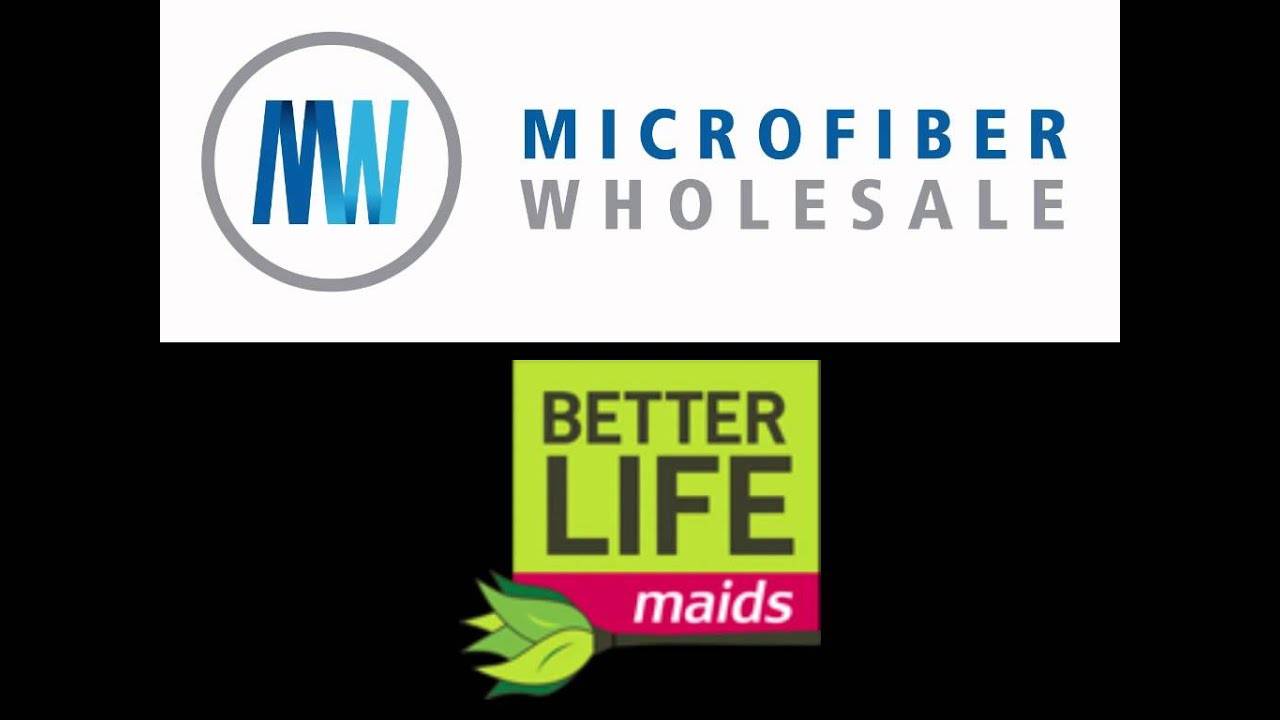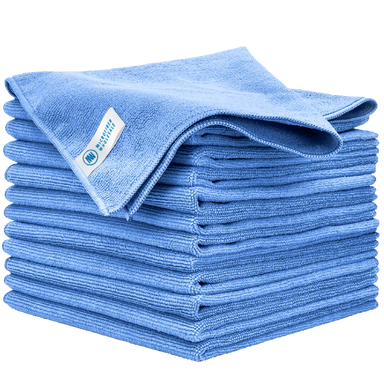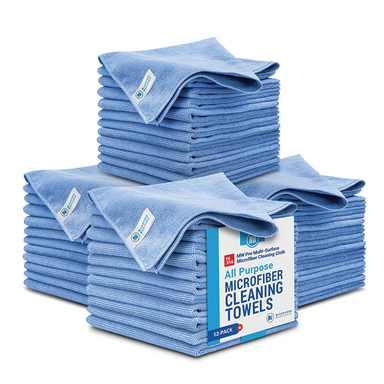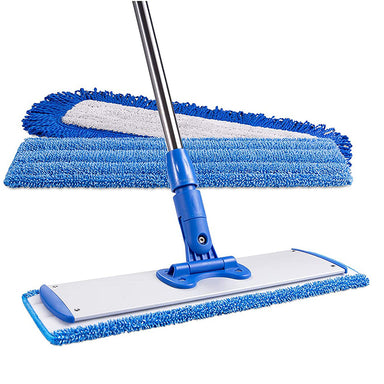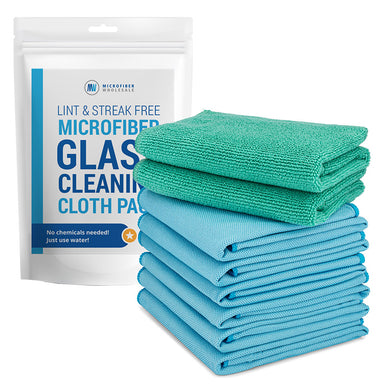LISTEN TO THIS SHOW AND LEARN:
The best way to structure your cleaning team for employee satisfaction and effectiveness
Tips to improve efficiency and reduce cost
Why you should send out more supplies with your cleaning teams
How to work with a professional cleaning company to extend the life of your products
How many washes you should be getting out of your Microfiber products
MENTIONS:
Vonigo
Better Life Maids
Better Life Cleaning Products
Net Promoter Score
Microfiber Mop Charging Bucket
Microfiber Towels
EDITORS NOTE:
In the interview, Matt mentions contracting with a commercial laundry to wash his microfiber and how he believes their equipment has extended the life of their microfiber. Refer to our recent article “Microfiber: Rent vs. Buy” for more on working with commercial laundries.
TRANSCRIPTION
[Welcome to the Microfiber Wholesale show where we talk with cleaning professionals about how to better run and grow your cleaning business. To learn more about who we are and what we do, visit us at microfiberwholesale.com.]
Host: I’m here today with Matt Ricketts. Matt, why don’t you tell us a little bit about your business, how you got started, and how long have you been doing what you do?
Matt: Sure. My company is Better Life Maids. We are a residential house cleaning company. We are founded in St. Louis in, wow, six years now so I guess going back to 2008. We’ve got locations in St. Louis; Birmingham, Alabama; Portland, Oregon; and St. Charles, Missouri as well now. We primarily focus on residential house cleaning and doing it in a more environmentally safe fashion so we have an entire line of products dedicated to that, the Better Life Cleaning Products that are a co-branded partner of ours.
That’s a very important part of what we do but also it’s about the tools and equipment. Of course, microfiber is part of that in providing our clients a much more beneficial cleaning experience reducing toxic chemicals and also reducing the waste. The traditional cleaning oftentimes causes paperweights and other by-products.
Host: Is that a big selling point or a way that people find out about you? They’re looking for that point of view?
Matt: I think it matters to a percentage of our clients. I think it’s more in alignment with my wife’s and I’s values. Of course, it resonates with some clients but for me, it resonates more with my values of how I would choose to do things, how I would choose to run a company, the way that I would want to be treated, the way that I would want to feel when I’m having my house cleaned. It runs from that and of course that’s going to resonate with your audience, too. You’ll align yourself with people that have similar values.
Oftentimes, that doesn’t necessarily make or break the sale. Ultimately, quality and craftsmanship still matter first. But I think of importance to that is if you are deciding between two companies that were of equal and quality craftsmanship. The one that takes the more—takes environment seriously is an important aspect to the business and also leaves your home feeling cleaner. I think that that makes the choice easier for clients.
Host: Well, as you’ve grown your business, what was a challenge you’ve kind of run into? What is the biggest challenge you’ve run into and how did you overcome it?
Matt: Well, as it relates to—should we need to go about how it relates to you guys or just in general?
Host: No, just in general. As someone running a cleaning company, what are some of the challenges you’ve faced that you’ve gotten through and how have you gotten through those?
Matt: Yeah, so somewhere, probably our biggest challenges are training and consistently bringing onboard new team members. We’re a fast growing company so developing a training program and providing them with a consistent template to teach them how we do things, to onboard them, and make sure that they’re a good cultural fit for our company, that they’re going to be delivering on our promises to our clients.
So, that’s definitely the biggest challenge that I think we face. I don’t think we’re alone in that. I think that’s sort of an industry-wide thing but I do think we’ve created some really great tools to help us differentiate ourselves in that regard.
Host: Were there any core takeaways you’ve had from that process?
Matt: So as far as that goes, one of the things we learned was that consistency is key on training new people, is that bringing them onboard, make sure that they’re working with other team members that have been trained properly themselves that are official trainers, that have the knowledge and the resources to pass on to them.
So, developing the trainers within your organization is important so there’s layers to your culture is what we learned and there’s different layers to what everyone’s roles are and you have to develop those sub-roles and key roles within your organization. Those will always give people within the organization an opportunity to come up too, so another key takeaway we had was growth is important because it gives other people opportunities to come up within your company as well.
Host: So people like to stay in the company because they’re seeing new opportunities, is that right?
Matt: That is true. So we have a lot of team members that stayed two, three years where specifically in this industry in residential cleaning. It’s not uncommon for someone to come in and come and go and but I think we actually get a lot of other competitors, team members from time to time. I mean, it happens that other people believe to come for us for higher pay, for the higher quality equipment that we provide, tools and equipment. Those are all things that we find are competitive advantages and they know that they will have an opportunity to grow into a field service leadership position and potentially an office position with new locations opening.
Host: Looking back, what else have you learned from any mistakes? Is there kind of any missteps you’ve taken that you’ve taken lessons away from?
Matt: Yeah, I mean, one of the things that we thought—it was like a key driver to our success early on—was a commission based structure of pay. We really believed in it for a long time but it overcomplicated our payroll. It made for just a really complex structure in how people saw themselves within the company. And so what we realized is that complexity is a negative so keeping things simple and straightforward in how we pay, how we promote, how we reward excellence. It’s more important than giving them a bonus structure that they can oftentimes excel in but sometimes can be confusing. So simplicity is really important to us.
Host: So how are you structuring it now that you’ve found to be most effective?
Matt: So we have created three team positions within our company so as far as field service: team supervisor, assistant team supervisor, and just team member. We’ve given them a path to grow into these positions and then as far as bonus structure goes, they have a flat hourly pay now and their bonus stays on their survey results instead of a much more complex system.
Basically we use net promoter score which is a system of asking your clients how they feel about your company, how likely they would be to recommend you. Team members that score well that also generate reviews and positive buzz for the company earn points and rewards based on that. It’s pretty straightforward. They understand it. It’s simple. They can see it on a real-time basis because we keep a scoreboard and they know where they stand.
And they know—they actually have a number that’s related to them and that creates a competitive thing where they know what their score is and they can compare it to other people within the company. So I think that that structure is simpler. Well, it took a little bit of time to develop. It’s better for us than a very complex commission structure.
Host: Well, moving to a few more specific questions here. Is there a specific strategy or method you use for cleaning a home? Do you start in a certain spot? Do you go room by room? Do you go cleaning tool by cleaning tool?
Matt: Well, so, I will give you one thing that we do that’s really—you need to use two of your products and it also kind of go over—I mean, this is a good question as well. I guess I can kind of come into this in circle back up. The way that we typically approach cleaning is is that you would have the same start points, same stop point every room you work. You’d work in a pattern, left to right, top to bottom. I think that’s pretty industry standard.
We look at ways of increasing efficiency in our cleaning, reducing waste, things like that but simple things like having 50-foot extension cords while we clean helps us avoiding plugging in 10 times on the floor if you’re just using the cord on the vacuum. So we look at a lot of different efficiencies within what we do. Because I think our hourly rate might be higher than other companies because we’re paying our people more and things like that. But we’re able to actually oftentimes clean in less time because of that training and efficiency, so we might be able to do a better job in 15 minutes less than other company and stay on target as far as pricing because of that and still pay our people better.
We have to get our clients to understand that that’s we’re shooting for. It’s that efficiency in their home and that it’s not about time. It’s about getting the job done. But we do, I feel, a good job about educating our clients about that, about educating them on the level of people that we’re looking for to work with in their home.
And then some of it has to do with some ideas we’ve used in to your products that we use pretty effectively to that extent would be—you guys have a mop bucket system that’s like an enclosed system. I’m not sure what you guys call it. We just call it the mop bucket system. It’s blue bucket with the lid that clasps down. We pre-soak microfiber mops in that, about 30 to 40 for the day. In that way, they’re not spraying and washing floors. They’re actually taking those out, just swing them out gently and then dent mopping floors after they’ve vacuumed and on the hard surfaces of the home.
As an example of efficiency, this allows us not to have to be—a lot of companies are filling buckets in clients’ homes, things like that. But it also avoids using dirty water, things like that, because only clean mops come out of that system. Nothing dirty ever goes back into it. So it’s also a selling point to our clients, we’re not going to cut corners and use the same mops that were used in another client’s home on your floor. That efficiency is also a selling point in the relationship with the client.
Host: Yeah, I really like that. Are there any other ways you specifically use microfiber mops and towels? People call in and ask us about the different ways they get used and we’re always curious what those are.
Matt: Well, so, one kind of specific example is we use microfiber dusters and we always do two trips around the room while we’re dusting and so we’ll high dust all the surfaces in the room. I mean, that’s fairly common. We like microfiber dusters because they can be washed. As long as you don’t dry them, they tend to last for quite a few washings. They don’t plump up. If someone makes a mistake of adding heat to them, then yeah, they won’t last long. We really like microfiber dusters for dusting over like lamps and all other things.
Microfiber cloths, I’m a big proponent of sending out to our teams so there’s much class as they need. You guys have a really good price point that I feel comfortable sending out, basically about 20 per home. I know companies that send 20 for the whole day and I think that might have to do with how much supplies cost or whatnot. We do a lot of laundry because of that. But, I feel like not skimping on that.
Oftentimes, we’ll come back with half those because good microfiber really uses less moisture, traps dirt better. So we may not use all but I want to make sure they have enough supplies to go out for the day and getting them at a lower price or from you allows us to send it out with a pretty large contingency of supplies, dusters, mops, microfiber cloths. We color code them for use, too, so you guys sell it for colors not so much in the same way other companies do.
We have several products that don’t work well together like our stainless steel cleaner. If you were to start using it on glass afterwards, it would really streak things up. So we color code those so that they’re not re-used after they’ve been used on a surface like the stainless steel refrigerator or stove and the same thing for our wood polish. There’s just kind of a light wax to it. You wouldn’t want to use that again on other surfaces.
Host: Are there any tips you have for extending the life of different products you use and getting more use out of them?
Matt: As far as microfiber goes, we’ve had really great success getting our microfibers to last up to almost four, five hundred washes so one thing that we do is—and this is kind of a big investment but potentially, if you’re a larger maid service or you’re trying to grow, I feel like this is something that will help make your company last is we actually have—I believe we have four or five days worth of supplies.
So we have—if we have 10 teams, that means we have 1,000 microfibers on hand to do this but we actually have a professional laundry service come in and pick up our linens. We’ve negotiated a really great price with them. Their equipment takes way better care of our microfibers. They come back in much better shape than just using home-based washing machines which do fine work but this is something we found to really—it has extended the life of our microfiber quite a bit and gets the soil out even more so.
There’s lots of companies that will do that but if you’re going to wash it, frontloading washing machines we found to be better and then not using high heat on our microfiber products, tumble drying as best as we can, those kind of extend the life on the products.
Host: Are there any other—outside of microfiber, any other kind of key tools you use for running your business whether that’s physical equipment or software. Is there anything you rely on day-to-day?
Matt: Yeah, we definitely have invested in software as a key component of what we do. So, definitely some tools. One of our vendors for software is called Vovigo. I highly recommend them. They help level the playing field against some of what I consider the new entrants into the field that everybody’s scared of, the Homejoys and things of that world because we have online scheduling just like Homejoy.
We have the ability for our clients to pay for their cleanings in an online portal just like Homejoy. This is a software that anybody can get their hands on. They typically sell to multi-unit companies but I think they’re about to do a roll-out of a release that will allow them to sell to single units. So that software, that feature is something that allows you to sell online 24 hours a day.
We’ve also created some things in-house like an instant quoting software where someone goes to our website and we capture the lead when they give us information for a quote and that lead information is nurtured through our software system. At first, it takes them to the online scheduling so they can see what’s available but also goes into our database immediately where they’re going to get follow up calls from our sales people. So, good software. The technical side of that can really help your business if you find something that improves your sales flow basically.
Host: Coming back, one of the things we like to ask in these interviews is why people do business with Microfiber Wholesale? We want to understand how we can serve customers better. So what is it about doing business with us that you feel is beneficial for your company?
Matt: So, obviously price is important. The quality of the microfibers has always been good. But the price at the quantities you sell at is really typically—it’s a sweet spot for us. So we can always order more and maybe find a cheaper distributor at few pennies less per piece if we ordered 10,000 pieces or 5,000 pieces or even sometimes even 1,000 pieces. But sometimes we don’t need 1,000 pieces. We just need 200 and it doesn’t make sense to order a crazy quantity. So at the volume you guys sell at, the price points are really great.
The quality of the microfiber coming through is really great. There’s the difference. Sometimes you can pay 50 cents for a cloth from a similar company. Yeah, you save 20 cents a cloth but then it only lasted 200 washes, and so you really didn’t save anything in the end. You probably spent 20 cents more for microfiber if you’re not looking at life cycle. So we’ve had good luck with life cycle.
And then just the variety of equipment, things like the fact that we can get our mop walls directly from you guys, that mop bucket system. We’d found something similar before but at a different price point and a slightly more brittle material where yours is a little bit more flexible and it’s held up well over time. The seals are held up and that’s been a really nice price.
So a variety of products, price point for the volume of things that you’re buying. Those are important so I think a lot of businesses, a lot of maid service businesses, they don’t need to buy 10,000 microfibers alone. That’s just an unrealistic number to buy at. The fact that I can come on your website, I can work with you guys on getting the commercial pricing, and then I’m not sure whether you are fixed now from the—your top tiered price, tiered lower tier price, but it’s a low enough number that you can make that order and feel comfortable you’re getting a great deal.
Host: That’s certainly what we’re looking for to make sure we’re providing the best value. You said the products have held up pretty well for you. They’ve been more durable than some other vendors you’ve worked with?
Matt: Well, I mean, we’ve certainly bought more expensive products that are supposed to be like Swedish microfiber that is supposed to hold up all that great and we haven’t seen any considerable difference. And then at times, in the past, we’ve ordered 1,000 pieces from other vendors and not been happy with the way that they’ve held up their—and the fact that they may be cloggy a little bit but over time it will feel a little bit dull, like you’re not catching as much dirt and stuff anymore.
It’s definitely a sweet spot. You could spend a whole lot more per piece and sometimes there is a difference in quality as you go up but where do you need that? Is that best served for the purposes that we’re doing? Would it be better just to have two cloths instead of getting the same cloth? If it’s affordable enough just to buy two instead of one four-dollar cloth so I can buy four 80-cents cloths.
There’s a justification you have to come in somewhere. Does that extra manufacturing process that these other brands might have, is it justified? And it may be, but not necessarily for the commercial purposes that we’re putting in through and then definitely with the cheaper microfibers, you don’t get the value in durability. They just tend to not hold up as long. Usually we’re seeing sometimes as few as 200 washes when we use other sources. So we’ve been really happy with—we feel like 500 washes is a pretty realistic number.
Host: Yeah, I think from people we’ve spoken with, that’s what we like to see as well. Tell us about are there any other vendors you frequently work with that you have a good relationship with? You mentioned Vonigo. I don’t know if anyone else came to mind.
Matt: That’s pretty much our primary outside vendor. Better Life, obviously, it’s a co-branded company but their products are great. They’re available for any cleaning service. We hire–
Host: Yeah, tell us a little bit about that.
Matt: Better Life is, again, another company founded here in St. Louis. They’re good friends of ours and they were kind of being founded at the same time. Initially, we were branded differently but we approached them about our idea of kind of co-branding, creating a premium company and then we’d be using all their products because we love them so much.
It was a win for us because now, they’re carried in—I think they’re going close to getting into Target. They’re in Whole Foods coast to coast. I feel like they will be a name brand and a household thing in the next few years. They’re actually featured on Shark Tank last fall and received a funding and actually one of the better deals that I’ve ever seen, came in there with a good pitch and good revenue and made a good strong case for funding and Laurie from QVC picked them up.
Host: That’s awesome!
Matt: Yeah, I think that relationship is helping them grow as well. So a big exposure obviously was huge. too, because that day, we were at a party for the night that the show aired. Me and Aaron who is their kind of back office, kind of warehouse manager who does a lot of the web sale stuff, we’re just watching on the phone, just thousand of orders pouring in as the show is airing. It was insane! So obviously, that’s great. Great PR for them.
It had a lift for us as well at the time and it still continues to. The products are amazing. They’ve really helped us with that mission of providing a much safer, greener experience for our clients and there’s really no compromise in how they’ve done it. It’s just really all natural, plant-based, green products, no petrochemicals, no toxic chemicals.
They actually even work with Whole Foods to set the standard of what is a greener, safe product. They helped with Whole Foods. Kevin is one of our chemists who worked with Whole Foods to help develop what they call an Eco-Scale. How they could rate all the products to come into Whole Foods as far as the cleaning of products and other chemicals that Whole Foods will carry. They have the minimum standards and the Better Life team helped in that development process.
Host: Well, that’s awesome. We always like to see more high quality vendors come into the space. We’re excited to let people know about that and we will put a link on microfiberwholesale.com so if anyone wants to check that out, you can do that there.
So Matt, that’s all I had for you today. Thank you very much for talking with us and everyone else, thank you for giving this a listen. Again to learn more about who we are and what we do, you can visit us at microfiberwholesale.com. Thank you very much.
Matt: All right. Thank you.









